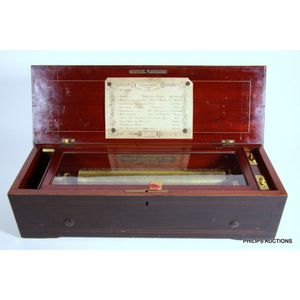Victorian Burr Ash and Ebony Deed Box with Inlay
You must be a subscriber, and be logged in to view price and dealer details.
Subscribe Now to view actual auction price for this item
When you subscribe, you have the option of setting the currency in which to display prices to $Au, $US, $NZ or Stg.
- Burr - Burr (or in the USA, burl) is the timber from the knotted roots or deformed branch of the tree, which when cut, displays the small circular knots in various gradations of colour. It is always cut into a decorative veneer, most commonly seen as burr walnut on 19th century furniture.
- Mother-Of-Pearl - Mother-of-pearl, technical name "nacre", is the inner layer of a sea shell. The iridescent colours and strength of this material were widely used in the nineteenth century as an inlay in jewellery, furniture, (especially papier mache furniture) and musical instruments.
In the early 1900s it was used to make pearl buttons. Mother-of-pearl is a soft material that is easily cut or engraved.
Nowadays it is a by-product of the oyster, freshwater pearl mussel and abalone industries. - Ebony - Ebony is a close grained timber, black in colour. It has a fine texture which can be polished to a high gloss, making it suitable for venereering, inlay and stringing and its use as solid timber is resticted to small decorative items and ornamental decoration, such as chess pieces and musical instrument parts. The term "ebonised" means "faux ebony", timber that has been darkened during the polishing process to resemble ebony.
- Victorian Period - The Victorian period of furniture and decorative arts design covers the reign of Queen Victoria from 1837 to 1901. There was not one dominant style of furniture in the Victorian period. Designers used and modified many historical styles such as Gothic, Tudor, Elizabethan, English Rococo, Neoclassical and others, although use of some styles, such as English Rococo and Gothic tended to dominate the furniture manufacture of the period.
The Victorian period was preceded by the Regency and William IV periods, and followed by the Edwardian period, named for Edward VII (1841 ? 1910) who was King of the United Kingdom and the British Dominions and Emperor of India for the brief period from 1901 until his death in 1910.
This item has been included into following indexes:
Visually similar items

A rosewood and mahogany-cased music box, 19th century, Swiss, rectangular with floral marquetry in coloured woods within cartouche to lid, brass mechanics, hand winder and original list of play tunes documented under lid, (not operational and some wear). H

A Nicole Freres of Geneva rosewood cased music box, 19th century, with retailer's label for Keith, Prowse & Co, Cheapside, in working order, with a floral inlaid panel and stringing to the lid and playing ten airs, with play list under the lid, having a br

Victorian rosewood & brass bound gentleman's dressing case with mahogany with red Morocco leather linings, three brass inlaid ebony lidded compartments, two large cut glass rectangular bottles, two small cut glass circular bottles with crested sterling sil

A painted Carpenters tool chest, with superb mahogany lined interior with drawers and the flame mahogany top with elongated sectioned inlay, side carrying handles, height 62 cm, width 93 cm, depth 63 cm
